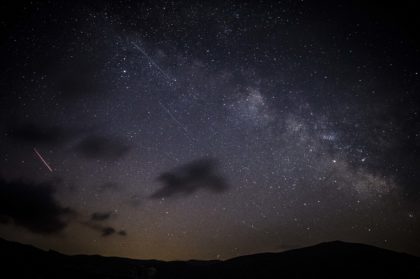
The release of Don’t Look Up around Christmas and Epiphany seems like a gift to sermon writers. The film depicts celestial message of impending doom that too many refuse to look up and see. Well, you know who *did* look up? Some Magi, and what they saw heralded salvation, not doom, for the world. Of course, the film was topical for other reasons. When writer-director Adam McKay scripted the film pre-pandemic, he had no idea that reality was an a collision course with his comedy, forcing him to reportedly alter or cut sequences that were too close to how the pandemic played out. What interested me most, however, was the way it overlapped with another Christmas release, The Matrix Resurrections.
Don’t Look Up is also the slogan of a reality-avoiding campaign within the narrative, intended to prevent followers from seeing the comet heading straight toward Earth. The machines of The Matrix go to much greater lengths to keep people from knowing the truth, constructing an entire simulated world for them to experience because anywhere they look in the actual world would give away the lie. That simulation persists after the end The Matrix Revolutions in 2003 and into last year’s The Matrix Resurrections. And so waking up to what’s really going on is a major plot concern of both Don’t Look Up and Resurrections.
The awakenings in The Matrix films tend to be personal. From what we see, helping one individual see the light involves sophisticated operations coordinated among agents inside and outside the eponymous simulation. The process is customized for what each person can understand and seems likely to respond to. This probably reflect the personal aspect of the films for Lana and Lilly Wachowski and their unfolding relationships with their transgender identities. Of course, discovering who you really are or learning the world is not everything it seems is a journey many have related to from a variety of perspectives, but some element of personal discovery remains a common theme. Don’t Look Up is more concerned with a collective awakening, trying to use a single message to get an entire population to take a simple action: look up. Once the comet is close enough to be visible without a telescope, that’s really all it takes to find out the truth.
I think I’m fixated on that feature of both stories because I’m still wrestling with the questions I raised almost two years ago now, writing about counterfactuals. Don’t Look Up has both climate change and the COVID-19 pandemic on its mind, two challenges that have the potential to impact everyone but on a day-to-day basis those effects are not necessarily tangible. You can’t feel a half-degree rise in average temperature over years. Strains on the healthcare system are more acute, but easily missed if you don’t work there or need immediate care. Of course, the relevant data are readily accessible; anyone can see charts of temperatures or case counts. But those are heavily mediated experiences of reality, creating greater opportunities for doubt and distrust.
And of course, just bringing awakening isn’t by itself a solution to our actual challenges. In the world of The Matrix, the discovery largely is the point; the point from there is to encourage freedom and choice. And in Don’t Look Up, the solution is apparently a space mission to divert the comet, a task for a relative handful of specialists. Getting people to see the comet is largely incidental to whether it will be stopped. Climate change and the pandemic are more complex problems and don’t have singular endpoints. Individual choices about one-time or daily activities are not entirely inconsequential, but we also cannot mitigate all of the consequences by making the right choices one-by-one. Or perhaps to put it another way, we need everyone to do their part, but not everyone’s part is the same size and many of them have dependencies to be possible or effective. Simply agreeing that the challenges exist is obviously necessary to that process, to but it is far from sufficient.

Maybe the next helpful step would be a more robust model for cause and effect, so the wider public can understand not just the existence of the challenge but also why it has occurred and what actions can affect outcomes. “Correlation is not causation” is a popular–and accurate–mantra, but where’s the follow-up to clarify what is? Meanwhile, post hoc sure does make a tantalizingly intuitive case for propter hoc. I’m currently reading Judea Pearl and Dana Mackenzie’s The Book of Why which summarizes work on formalizing notions of causality. Counterfactuals factor prominently; they also appear in constructor theory, a formulation of physics described by Chiara Marletto in The Science of Can and Can’t. Informally, we can say A is a cause of B if doing A increases the probability of B occurring, relative to when we don’t do A. Sometimes, as in randomized clinical trials, we can do A sometimes and not do A sometimes and see how that impacts B. But sometimes we can’t (or shouldn’t) intervene so directly, in which case we need to consider counterfactual realities where the status of A differs from what actually occurred.
For research, we usually need models to test counterfactuals, or similar conditions across time and/or space which most just differ by the status of A. For communication purposes, however, perhaps sci-fi storytelling has a role in enlightening us about causality when it comes to climate and contagions. As I brought up previously, you can’t experience counterfactuals directly because of their intrinsic unreality. But stories are not constrained but what did or will happen and so they are quite free to depict counterfactual scenarios. Really every fiction already is a counterfactual; it’s just a matter of identifying the most salient alternatives to illustrate. A Groundhog Day or Edge of Tomorrow style time-loop movie might be useful, to illustrate the outcomes of different choices.
In the terms of Aristotle or Aquinas, what we’d be exploring and what Pearl and Mackenzie are talking about are material and efficient causes. We can also discuss final causes–purposes or ends–and specifically, our purpose for attempting this kind of communication and education. Certainly one end is to achieve better outcomes for humanity, including less disease and suffering, as a way of loving our neighbor. At the same time, sharing the truth is also a way to show love to our neighbor, not just as a means to reducing suffering but as an end unto itself. The impulse to frame conversation as debate and confrontation makes it easy to see the alternatively informed as opponents–a perspective Don’t Look Up seems to reinforce–but the reality is they are just as much a part of the humanity we are trying to get better outcomes for. Here I think The Matrix films are more helpful; they depict sharing reality more clearly as an act of service and love.
Admin note: Just a reminder that my posts have shifted to a monthly schedule, on the second Wednesdays of each month. But stay tuned for more from Julie Reynolds in coming weeks. And other contributions on science & faith topics are welcome also.
Andy has worn many hats in his life. He knows this is a dreadfully clichéd notion, but since it is also literally true he uses it anyway. Among his current metaphorical hats: husband of one wife, father of two teenagers, reader of science fiction and science fact, enthusiast of contemporary symphonic music, and chief science officer. Previous metaphorical hats include: comp bio postdoc, molecular biology grad student, InterVarsity chapter president (that one came with a literal hat), music store clerk, house painter, and mosquito trapper. Among his more unique literal hats: British bobby, captain’s hats (of varying levels of authenticity) of several specific vessels, a deerstalker from 221B Baker St, and a railroad engineer’s cap. His monthly Science in Review is drawn from his weekly Science Corner posts — Wednesdays, 8am (Eastern) on the Emerging Scholars Network Blog. His book Faith across the Multiverse is available from Hendrickson.

Leave a Reply